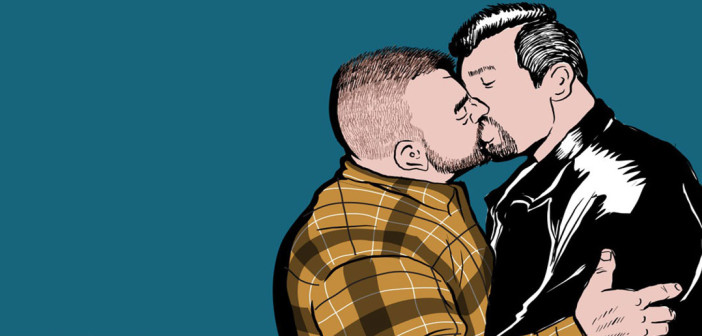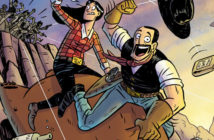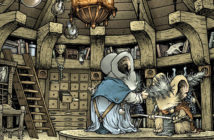Steve MacIsaac is a superior storyteller of the human condition, and his independent series, Shirtlifter, operates as his ongoing magnum opus. MacIsaac, a gay man residing in Long Beach, California, certainly is not shy about sex—at least in his comics, anyway. His books boil with homosexual eroticism, and upon initial consideration, they’re easily labeled pornography because of the explicit content’s depth and breadth. But don’t be mistaken: they’re not just purely pornographic. They’re simply honest.
Steven MacIsaac recently took the time to talk with me for Broken Frontier about his comics and the meaning behind them…
BROKEN FRONTIER: Shirtlifter is a story exploring and understanding the homosexual condition, from coming out to living life as a gay person. Would you be comfortable sharing a little bit about your personal experience in this arena?
STEVE MACISAAC: You hear about “gay culture,” or, more pejoratively, the “gay lifestyle,” and I can’t even pretend to understand what these entail. Which lifestyle? There’s this perception that being gay is this singular hive mind, even sometimes among gay people. The experience of being gay varies depending on your ethnic background, whether you were raised in an urban or rural environment, and varies by the age you became aware of and were certain of your sexuality, by your peer group, and by your body type.
I think there are multiple overlapping gay identities, often with contradictory tenets. More flamboyant guys tend to think of the traditionally masculine set as self-loathingly uptight, in thrall to an oppressive norm of masculinity, while the “masculine” guys see the flamboyant guys as caving in to the false expectation of straight culture that gay men must be perpetually other, that we don’t fit in and are inherently something between genders, rather than an offshoot of masculine identity. Both sides have valid positions; I sure don’t have an answer to that question. All I can do is try and hint at that complexity in my work.
BF: In my original review of the first three issues of Shirtlifter, I called your book on more than one occasion “pornography.” How do you view this label in terms of your work? Do you find it a fair term, do you prefer erotica, or are you indifferent?
MACISAAC: I don’t think Shirtlifter is pornography per se, but it’s obviously sexually explicit, and a lot of the scenes are deliberately done with a pornographic gaze. So it’s obviously informed by pornography, and Sticky, the book I did with Dale Lazarov, was definitely porn. It was designed to arouse, to get people off. It did so in a meaningful, intelligent way I think, but arousal was definitely the goal.
That’s not what Shirtlifter is about. There are specific sequences which people have said they find arousing, but the primary goal of the sex in the book is to define a relationship or to evoke the experience of sex. And it’s also there sometimes as a bit of a decoy. Someone once told me that my comics have an uncanny ability to short-circuit desire—that I draw the viewer in with pictures of attractive guys and then slip in text or narrative cues that complicates or undercuts that arousal. That’s not too far off.
Mostly, I am interested in how sex defines people, how it can be a sublime way of revealing character and motivation. People let their guard down when you sleep with them; you often get to know them in a way that doesn’t happen when you’re simply friends. I think that’s one reason why, for gay men, sex is so often a path to or conduit for building friendships. It’s a big, complex, messy subject, one that I think is rich with meaning and ripe for exploration, all the more so since alternative comics have largely turned away from exploring sex as a subject matter.
I’m also resistant to the porn label because it closes so many doors. Most shops won’t carry adult material, let alone gay adult material. Diamond shunts you off to a separate catalogue that can’t be distributed outside the United States. There seems to be a general consensus that adult material is inessential and unserious. Which, statistically speaking, isn’t untrue: the history of adult comics is mostly the history of crap. But underground comics have a long rich tradition, and Shirtlifter really isn’t any more explicit than, say, certain works by S. Clay Wilson or Robert Crumb. It doesn’t adequately characterize what the work is trying to do.
BF: All right, but, then, what is porn to you?
MACISAAC: I would define it as work that has the specific goal of arousal and/or orgasm.
BF: Aside from a major release of a media event like “Brokeback Mountain,” gay men in the media tend to be portrayed as effeminate eunuchs. But I’ve noticed a very refreshing, honest, and genuine portrayal of the diversity of the gay community within independent comics. Why are comics, of all venues, a good conduit for exploring the gay experience?
MACISAAC: I think comics are a good conduit for exploring any subject, simply because of one of the medium’s formal properties is the ability to shift effortlessly between the interior to the exterior. I was interested in comics long before I came out, so it’s always been a medium that excited me. Gay experiences just happen to be what I am interested in documenting through comics, primarily because it was and is as an area that has been relatively unexplored in a significant and meaningful way. So I saw an opportunity.
But I think the content matches the form really well. Comics have an ability to marry the two approaches.
BF: Returning to what you originally said in your initial response, Shirtlifter clearly shows a segment of the gay community not often thought of. The gay men in your comics are muscular, burly, embrace facial and body hair, and are (to some) the concept of “real men.” With a realization like this, how far does the layman still have to travel before understanding what it means to be gay outside of expected stereotypes?
MACISAAC: I don’t know. I’m not exactly a bear evangelist. I write about “real men” because, honestly, they seem like the silent majority to me: they’re everywhere, but are unacknowledged by culture because you can’t necessarily tell by looking. Well, I can, but I know what to look for. Your average straight person doesn’t. To them, “gay” means a specific kind of thing, and that conceptualization is generally used to dismiss or vilify.
At the same time, I don’t want to be seen as this uncritical avatar of “masculine” and “straight-acting” guys. In the current issue, there’s a lot of conflict over that issue. “Real men” can be just as critical and not accepting of those they consider less masculine. It’s a complex issue.
But I don’t have an agenda: I don’t want to make the mistake of certain Bear-oriented films or novels which often read like manifestos or a Wikipedia entry. Bears don’t sit around and talk to each other about their “bear-ness”—they just hang out with their loved ones and live their lives.
BF: How much of this comic series is autobiographical and how much of it is fiction?
MACISAAC: Well, my autobiographical material, which comprised the entirety of Shirtlifter #2, is completely autobiographical, with the usual caveat that, of course, all authors embellish or alter reality to some extent. Some characters are composites, some events didn’t happen in the exact order or manner that I have depicted. I treat myself and the people I know as characters, and my number one priority is the creation of an artful story. That being said, if I am writing autobiographically, I do feel an obligation to get as close as possible to the emotional core of what happened, with a minimum of distortion.
The rest of my work is fiction. Make believe. My experiences factor into it of course, as do those of people that I know, but they’re not thinly veiled versions of my life. I lived in Japan, but Derek (Shirtlifter #1) is not me. I am Canadian, but my relationship experiences are very different from Matt’s (Shirtlifter #3 and #4). The reason I choose to tell fictional stories and not simply be an autobiographical cartoonist is because I don’t have personal experience with all the stories I want to tell. When it does, that’s when I choose autobiography.
BF: You have a near-masterful control over your dialogue and exposition juxtaposed to your imagery. Where does your inspiration as an artist come from?
MACISAAC: Masterful is kind considering how little I feel I am in control at times, especially when doing my first drafts.
As for inspirations, here is a partial list off the top of my head, crossing a lot of genres and media:
Jaime and Gilbert Hernandez, Kurt Vonnegut, David Mamet, Battlestar Galactica, Howard Chaykin, The Sopranos, Coil, Herge, Leonard Cohen, The Magnetic Fields, Twin Peaks, Dave Sim, Japenese Yukio-e prints, Ralf Konig, Phoebe Gloeckner, Flannery O’Connor, Brian Eno’s Oblique Strategies, German expressionism, Barbara Kruger, Lewis Trondheim, Grant Morrison, Roman Polanski, Homicide: Life on the Street, Jackson Pollock, Raymond Carver, Dylan Horrocks, Alex Toth, The Mountain Goats, Brad Fraser, 80s post-punk and industrial music, Robert Mapplethorpe, Cloud Atlas, Peanuts, Tom of Finland, Alison Bechdel, The Wire, Fabrice Neaud, Annette Messager, Marc Rothko, Ernest Hemingway, Blutch, Dupuy and Berberian, Warren Craghead, Ingmar Bergman, old Bodybuilder magazines, Edouard Manet, Jose Munoz and Carlos Sampayo, John Porcellino.
The books and comics and music and art and films I like all wind up in my work somehow, but not because I look at these artists and try and copy what they do. It’s more that the people or art on this list opened me up to thinking about approaching my work in a different way than I would have previously.
BF: What’s your process like as a creator? Since you’re both your own writer and artist, do you write scripts and then illustrate, or is it more chaotic? I’d love to know more.
MACISAAC: The process varies. When I am doing short pieces, I have a vague idea that I depart from and just start brainstorming. Sometimes I just write a lot of dialogue or an interior monologue—techniques left over from my playwriting days—sometimes I just have an idea for image that I want to work into the scene. I work backwards and forwards, building the story up page by page, scene by scene, until I have a rough draft.
Then I start editing: cutting, revising, redrawing, re-sequencing, editing, deleting, rearranging, rewriting, until I have something that works. I always wind up drawing more than ends up in the finished book, so it’s not a particularly efficient way of working, but I like the process of discovery that it allows for. Surprising myself is important for me to keep things interesting.
With “Unpacking” (Shirtlifter #3 and #4), which is my first really long piece, the process is a bit more organized. Because I serialized the rough draft of books one and two online, I drew them in chronological order, which is a first for me. I have an outline of the story mapped out: it’s always been planned as three books, and I planned the big plot points that happen in each one. But other parts of the story I only sketched in vaguely, to be made up as I was drawing it. Because I’m slow (demanding day job), I don’t want to spend 10 years of my life only transcribing ideas that I came up with when I was 35-years-old. That seems like death to me. But something in between a full script and seat of the pants seems to work for me.
BF: How do you make your illustrations?
MACISAAC: I work digitally, using two different illustration programs. I create the page templates and do the “under-drawing” (my version of pencils) in Illustrator, drawing with a Cintiq. I then export the page over to a (now orphaned) program called Creature House Expression, which has great vector brushes that allow me to get a really good thick/thin line variation when I vary the stylus pressure. I then export if back to Illustrator for coloring and final tweaks.
BF: Have you ever shopped your stories around to publishers, either in comics or mainstream publishing, to try and find a wider audience?
MACISAAC: I’ve worked with publishers. Sticky, my first book, was published as a series by Eros Comix at first, and then was collected by Bruno Gmuender in Germany. Stories have been included in anthologies by publishers like Houghton Mifflin, Last Gasp, and Arsenal Pulp Press. I’ve talked to an agent about “Unpacking,” but I’m really not pursuing that until it’s a lot closer to completion.
I’m not opposed to the idea of publishers. Honestly, I think that my comics have a built-in limitation to their appeal. Most straight people are unwilling to read comics with gay protagonists, unless there’s some kind of built in ironic distance. Selling 2,000 copies of my work as a self-publisher means that I make some money doing it—not nearly enough to live on, but something—even if it just gets rolled back into the printing bill for the next issue, over time it gets easier and easier to be in the black, and I have a blacklist.
Selling that amount for a “real” publisher, I’d get five to 10 percent of the cover price, the issue would go out of print because it didn’t sell enough to justify a reprint, and the comic would blink out of existence. I am a terrible publisher, have done almost no self-promotion, and I still have sold more issues of Shirtlifter by myself than Eros ever did with Sticky. If I’m going to be obscure, I’d rather be obscure and retain control over my work. At least this way when I fail, I know who to blame.
BF: What have reactions to your comic been like thus far?
They run the gamut. I tend to hear from the enthusiastic people—the ones who bother to write or who come by the tables as conventions. The work speaks to them, they see themselves and the lives of their friends reflected on the page. I met one guy online who had posted an image of mine on his profile asking who the artist was; he’d found the sequence on someone’s blog somewhere, but he didn’t know who did it, but he felt like I’d broken in to his home, spied on him, and was writing about his life. Obviously not in the details – he’s not a graphic designer, he’s not Canadian, he’s not afraid of commitment. But he’s able to universalize the experience from the particulars, which is what I think art asks us to do.
But there’s a lot of indifference. When I released issue three, I sent sample copies of the first two issues to stores across the country and asked them to order copies through Diamond, even offering a lot of free samples, but didn’t get much response. The stores that order it and display it tend to do well with it. But the comics industry really marginalizes gay content. And gay creators self-marginalize to a certain extent, as well.
This interview originally appeared on Broken Frontier.




